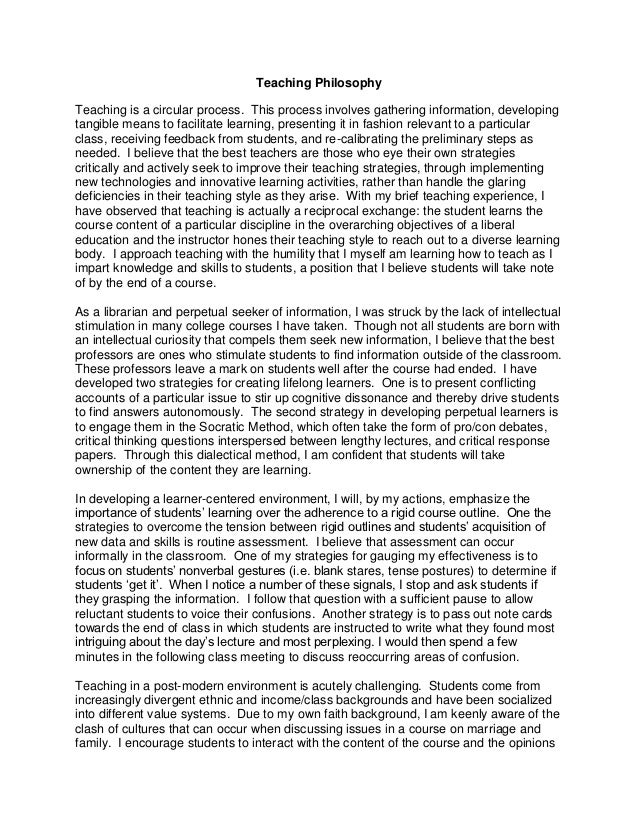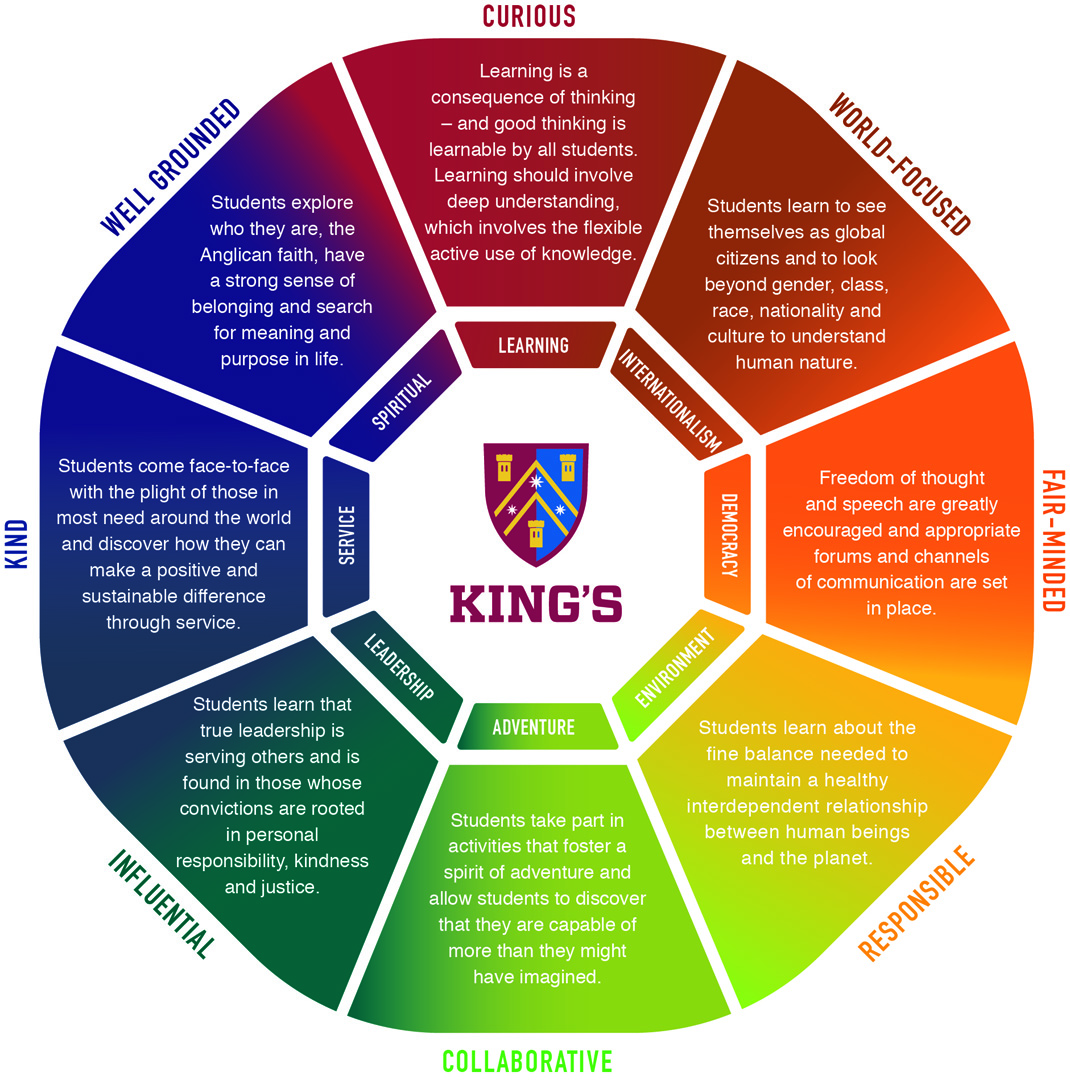Philosophy of teaching statements are concise statements of what you believe about the teaching and learning of languages or literature, and possibly also about education in general. Most sources recommend that you keep your teaching philosophy statement between one and two pages in length, covering what you believe, why, and brief examples of.
| Discipline | Philosophy, education |
|---|---|
| Language | English |
| Edited by | Maralee Harrell |
| Publication details | |
| History | 1975–present |
| Publisher | |
| Frequency | Quarterly |
| Standard abbreviations | |
| ISO 4 | Teach. Philos. |
| Indexing | |
| ISSN | 0145-5788 (print) 2153-6619 (web) |
| LCCN | 76-649637 |
| OCLC no. | 2773264 |
| Links |
Teaching Philosophy is a peer-reviewedacademic journal devoted to the practical and theoretical discussion of teaching and learning philosophy, that is philosophy education. Established by Arnold Wilson in 1975, it has published over 2,500 articles and reviews in this field. Notable contributors include Norman Bowie, Myles Brand, Peter Caws, Angela Davis, Daniel Dennett, Alasdair MacIntyre, Rosalind Ladd, Michael Pritchard, Anita Silvers, and Robert C. Solomon. Members of the American Association of Philosophy Teachers and the Philosophy Learning and Teaching Organization have access as a benefit of membership. This journal has a Level 1 classification from the Publication Forum of the Federation of Finnish Learned Societies.[1] and a SHERPA/RoMEO 'green' self-archiving policy.[2] It is published on behalf of the Teaching Philosophy Association by the Philosophy Documentation Center.[3] Tuxera ntfs full mojaveyellowray.
Topics covered[edit]
Topics frequently covered include:
- Your teaching philosophy should reflect your personal values and beliefs about teaching. It is a self-reflective statement that describes both what you believe and provides concrete examples of what you do in the classroom to support those beliefs. It is written in first person and should convey a professional image of your teaching.
- My educational philosophy is that I believe all students are capable of learning. They all do not learn at the same rate, but with different methods and strategies it is possible. Students should not be thought of as mindless individuals just waiting to be filled with knowledge by their teachers.
- The Teaching Philosophy The teaching philosophy is a statement of one's beliefs and thoughts about what's important in teaching and learning. It's often a one- to two-page written description of how and why one teaches the way one does. It transcends every decision and directs the course of learning in the classroom.
- Teaching methods and the use of new instructional material
- Experimental and interdisciplinary courses with philosophical content
- Evaluation of teaching and assessment of learning in philosophy
- Critical examination of pedagogical problems
- Reviews of books, instructional media, software, and Web-based resources
Indexing[edit]
Teaching Philosophy is abstracted and indexed in Academic Search Premier, Arts & Humanities Citation Index, Contents Pages in Education, Education Research Index, ERIH PLUS,[4] Expanded Academic ASAP, FRANCIS, Google Scholar, Index Philosophicus, InfoTrac OneFile, International Bibliography of Book Reviews of Scholarly Literature, International Bibliography of Periodical Literature, International Philosophical Bibliography, MLA International Bibliography, Periodicals Index Online, Philosopher's Index, PhilPapers, Scopus,[5] and TOC Premier.
Awards[edit]
The following articles have received the biennial 'Mark Lenssen Prize for Publishing on Teaching Philosophy' from the American Association of Philosophy Teachers:[6]
- Ann J. Cahill and Stephen Bloch-Schulman, 'Argumentation Step-By-Step: Learning Critical Thinking through Deliberative Practice', Vol.35, Nr.1 (March 2012), pp. 41–62.
- John Rudisill, 'The Transition from Studying Philosophy to Doing Philosophy', Vol.34, Nr.3 (September 2011), pp. 241–271.[1]
- Daryl Close, 'Fair Grades', Vol.32, Nr. 4 (December 2009), pp. 361–398.[2]
- David W. Concepción, 'Reading Philosophy with Background Knowledge and Metacognition', Vol.27, Nr.4 (December 2004), pp. 351–368.[3]
- James Campbell, 'The Ambivalence toward Teaching in the Early Years of the American Philosophical Association', Vol.25, Nr.1 (March 2002), pp. 53–68. [4]
- Deborah Barnbaum, 'Teaching Empathy in Medical Ethics: The Use of Lottery Assignments', Vol.24, Nr.1 (March 2001), pp. 63–75.[5]
See also[edit]
References[edit]
- ^'Publication Forum web site'. Retrieved 6 May 2018.
- ^'SHERPA/RoMEO web site'. Retrieved 15 October 2018.Cite journal requires
|journal=(help) - ^'Teaching Philosophy website'. Retrieved 15 October 2018.
- ^'ERIH PLUS website'. Retrieved 6 May 2018.
- ^'Scopus website'. Retrieved 6 May 2018.
- ^'AAPT website, Awards - Lenssen Prize Winners'. Retrieved 2 August 2014.
External links[edit]
Example Of Professional Philosophy Statement
The teaching philosophy (or teaching statement) is becoming a more common part of academic life for both faculty and graduate students. Graduate students report that colleges and universities often request statements from applicants for faculty positions. Faculty at an increasing number of institutions must develop a teaching statement as they approach tenure and promotion. Instructors at all levels find that writing their statement helps them develop as teachers, since it entails making their implicit views on teaching and student learning explicit and comparing those views to actual teaching practice.
CRLT RESOURCES
Please also see:
RESOURCES FROM PEER INSTITUTIONS
The Ohio State University
- Teaching Portfolio guide
- Writing a Philosophy of Teaching Statement. Includes descriptions, purpose, major components, and examples across disciplines
- Guidance on Writing a Philosophy of Teaching Statement with additional rationales and models to follow
- GRIDS: Philosophy of Teaching Statement Staples
University of Iowa

- Components of a Teaching Philosophy Statement (Link to PDF)

Topics covered[edit]
Topics frequently covered include:
- Your teaching philosophy should reflect your personal values and beliefs about teaching. It is a self-reflective statement that describes both what you believe and provides concrete examples of what you do in the classroom to support those beliefs. It is written in first person and should convey a professional image of your teaching.
- My educational philosophy is that I believe all students are capable of learning. They all do not learn at the same rate, but with different methods and strategies it is possible. Students should not be thought of as mindless individuals just waiting to be filled with knowledge by their teachers.
- The Teaching Philosophy The teaching philosophy is a statement of one's beliefs and thoughts about what's important in teaching and learning. It's often a one- to two-page written description of how and why one teaches the way one does. It transcends every decision and directs the course of learning in the classroom.
- Teaching methods and the use of new instructional material
- Experimental and interdisciplinary courses with philosophical content
- Evaluation of teaching and assessment of learning in philosophy
- Critical examination of pedagogical problems
- Reviews of books, instructional media, software, and Web-based resources
Indexing[edit]
Teaching Philosophy is abstracted and indexed in Academic Search Premier, Arts & Humanities Citation Index, Contents Pages in Education, Education Research Index, ERIH PLUS,[4] Expanded Academic ASAP, FRANCIS, Google Scholar, Index Philosophicus, InfoTrac OneFile, International Bibliography of Book Reviews of Scholarly Literature, International Bibliography of Periodical Literature, International Philosophical Bibliography, MLA International Bibliography, Periodicals Index Online, Philosopher's Index, PhilPapers, Scopus,[5] and TOC Premier.
Awards[edit]
The following articles have received the biennial 'Mark Lenssen Prize for Publishing on Teaching Philosophy' from the American Association of Philosophy Teachers:[6]
- Ann J. Cahill and Stephen Bloch-Schulman, 'Argumentation Step-By-Step: Learning Critical Thinking through Deliberative Practice', Vol.35, Nr.1 (March 2012), pp. 41–62.
- John Rudisill, 'The Transition from Studying Philosophy to Doing Philosophy', Vol.34, Nr.3 (September 2011), pp. 241–271.[1]
- Daryl Close, 'Fair Grades', Vol.32, Nr. 4 (December 2009), pp. 361–398.[2]
- David W. Concepción, 'Reading Philosophy with Background Knowledge and Metacognition', Vol.27, Nr.4 (December 2004), pp. 351–368.[3]
- James Campbell, 'The Ambivalence toward Teaching in the Early Years of the American Philosophical Association', Vol.25, Nr.1 (March 2002), pp. 53–68. [4]
- Deborah Barnbaum, 'Teaching Empathy in Medical Ethics: The Use of Lottery Assignments', Vol.24, Nr.1 (March 2001), pp. 63–75.[5]
See also[edit]
References[edit]
- ^'Publication Forum web site'. Retrieved 6 May 2018.
- ^'SHERPA/RoMEO web site'. Retrieved 15 October 2018.Cite journal requires
|journal=(help) - ^'Teaching Philosophy website'. Retrieved 15 October 2018.
- ^'ERIH PLUS website'. Retrieved 6 May 2018.
- ^'Scopus website'. Retrieved 6 May 2018.
- ^'AAPT website, Awards - Lenssen Prize Winners'. Retrieved 2 August 2014.
External links[edit]
Example Of Professional Philosophy Statement
The teaching philosophy (or teaching statement) is becoming a more common part of academic life for both faculty and graduate students. Graduate students report that colleges and universities often request statements from applicants for faculty positions. Faculty at an increasing number of institutions must develop a teaching statement as they approach tenure and promotion. Instructors at all levels find that writing their statement helps them develop as teachers, since it entails making their implicit views on teaching and student learning explicit and comparing those views to actual teaching practice.
CRLT RESOURCES
Please also see:
RESOURCES FROM PEER INSTITUTIONS
The Ohio State University
- Teaching Portfolio guide
- Writing a Philosophy of Teaching Statement. Includes descriptions, purpose, major components, and examples across disciplines
- Guidance on Writing a Philosophy of Teaching Statement with additional rationales and models to follow
- GRIDS: Philosophy of Teaching Statement Staples
University of Iowa
- Components of a Teaching Philosophy Statement (Link to PDF)
Harvard University
- The Job Market offers descriptions, recommendations and goals of teaching statements for current and future faculty. Includes links and exercises to help readers reflect upon their teaching philosophy.
- Tip sheet: Instructions for a Teaching Statement Peer Review Workshop (Google Doc)
- James M. Lang, '4 Steps to a Memorable Teaching Philosophy,' The Chronicle of Higher Education (29 August 2010)
Teaching Philosophy Of Education
University of Saskatchewan
University of Minnesota
Vanderbilt University
FURTHER READING ON TEACHING STATEMENTS
- Corrall, Sheila (2017) Developing a Teaching Philosophy Statement. In: Workshop on Developing a Teaching Philosophy Statement, 19 June 2017 - 19 June 2017, Technological Higher Education Association (THEA), Dublin, Ireland.
- Dalton, C. L., Wilson, A., & Agius, S. (2018). Twelve tips on how to compile a medical educator's portfolio. Medical teacher, 40(2), 140-145. https://doi.org/10.1080/0142159X.2017.1369502
- Grundman, H. G. (2006). Writing a teaching philosophy statement. Notices of the AMS (PDF), 53(11), 1329-1333.
- Hegarty, N. C., & Silliman, B. R. (2016). How to approach teaching philosophy statements as career mission statements. Journal of Business and Educational Leadership, 6(1), 103.
- Montell, Gabriela (2003). How to Write a Statement of Teaching Philosophy (PDF), from the Chronicle Manage Your Career section of the Chronicle of Higher Education.
- Swart, Arthur James. 'Developing a comprehensive teaching portfolio—A scholarly personal narrative.' In Global Engineering Education Conference (EDUCON), 2018 IEEE, pp. 26-31. IEEE, 2018. https://doi.org/10.1109/EDUCON.2018.8363204
- Wesner, A. R., Jones, R., Schultz, K., & Johnson, M. (2016). Impact of the Use of a Standardized Guidance Tool on the Development of a Teaching Philosophy in a Pharmacy Residency Teaching and Learning Curriculum Program. Pharmacy, 4(1), 9. https://doi.org/10.3390/pharmacy4010009
RESOURCES ON WRITING A DIVERSITY STATEMENT
Along with teaching statements, many colleges and universities now consider diversity statements during faculty hiring and promotion. As this practice becomes more commonplace, we offer a selection of resources to help guide professionals interested in writing and improving their own statements on diversity.
- University of Michigan Rackham Graduate School workshop: Writing a Diversity Statement (see Rackham website)
- Golash-Boza, Tanya (June 10, 2016). The Effective Diversity Statement. Inside Higher Ed.
- Reyes, Victoria (January 25, 2018). Demystifying the Diversity Statement. Inside Higher Ed.
- Schmaling, K. B., Baker, D. L., Blume, A. W., & Trevino, A. Y. (2018). Applicant responses to diversity selection criteria in academic staff position descriptions. Journal of Higher Education Policy and Management, 1-16.
- UC San Diego Center for Faculty Diversity and Inclusion. Contributions to Diversity Statements
- Guidelines for Writing Statements (PDF)
- Guidelines for Evaluating Statements (PDF)

